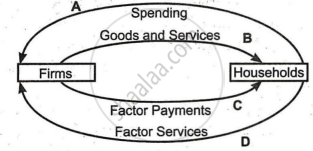Advertisements
Advertisements
Question
Why should the aggregate final expenditure of an economy be equal to the aggregate factor payments? Explain.
Solution
In a two sector economy, consisting of households and firms, the only way in which the households can dispose their income is on the goods and services produced by the firms. The factors of production use their remuneration to purchase goods and services. Thus, the income will come back to the producers in the form of sales’ revenue. So, there is no difference between the amount that firms distribute in the form of factor payments and consumption expenditure incurred by the households. The same process continues year after year. However, if there has been any leakage in the form of savings, imports or taxes, then there arises a difference between the aggregate consumption expenditure and aggregate factor payments. In the case of some leakage, the households will spend less than their factor incomes. Consequently, the firms will receive lesser amount in the form of revenue, which will reduce the production level and employment level. This process will continue in every successive round and production and employment levels will continue to drop. Thus, the equality between the aggregate consumption expenditure and the aggregate factor payments is very necessary for the smooth functioning of the economy.
APPEARS IN
RELATED QUESTIONS
Explain the circular flow of income.
What are the four factors of production and what are the remunerations to each of these called?
Answer the following question.
With the help of a diagram, show the circular flow of income in a two-sector model with Savings and Investment.
Answer the following question.
Give any two examples of the flow concept.
Money flow is the flow of ____________.
Which of the following is an example of macroeconomics?
Which one of the following services are included in the Secondary Sector?
Which one is the limitation of Macro Economics?
Draw a well labelled diagram of two sector model of a circular flow of income including the financial sector.
Read the below case and answer the question that follow:
Circular Income Flow in a Two Sector Economy: In the figure given we can see that upper loop shows the resources such as land, capital and entrepreneurial ability flow from households to firms in the direction shown by the arrow direction.

The money flows from firms to the households as factor payments in the form of wages, rent, interest and profits, shown by the arrow direction.
The lower part of the figure shows the flow of money from households to firms in the form of consumption expenditure done by the households to purchase the goods and services produced by the firms, making the flow of goods and services from firms to households.
Thus, we see that money flows from business firms to households as factor payments and then it flows from households to firms. Thus, there is, in fact, a circular flow of money or income. This is how the economy functions.
Circular flow of income refers to the flow of activities of production, income generation and expenditure involving different ______ of the economy.
Read the below case and answer the question that follow:
Circular Income Flow in a Two Sector Economy: In the figure given we can see that upper loop shows the resources such as land, capital and entrepreneurial ability flow from households to firms in the direction shown by the arrow direction.

The money flows from firms to the households as factor payments in the form of wages, rent, interest and profits, shown by the arrow direction.
The lower part of the figure shows the flow of money from households to firms in the form of consumption expenditure done by the households to purchase the goods and services produced by the firms, making the flow of goods and services from firms to households.
Thus, we see that money flows from business firms to households as factor payments and then it flows from households to firms. Thus, there is, in fact, a circular flow of money or income. This is how the economy functions.
Which of the following is not an assumption of a two sector model of Circular Flow of Income?
Which of the following is a flow?
Identify the correctly matched pair of the items in Column A to those in Column B:
| Column A | Column B |
| 1. Money Flow | (a) Depreciation |
| 2. Real Flow | (b) Factor Services |
| 3. Trade Flow | (c) House Work by Housewife |
| 4. Capital Flow | (d) Inventory |
Giving valid reasons, explain how the following would be treated while estimating National income:
- Payment of indirect taxes by a firm.
- Purchase of goods by foreign tourists.
Giving valid reasons, explain how the following would be treated while estimating domestic income?
- Payment made by a Japanese tourist for goods purchased in India.
- Broker's commission on the sale of second hand goods.
On the basis of the figure given below, identify the type of flow indicated by B and D:

